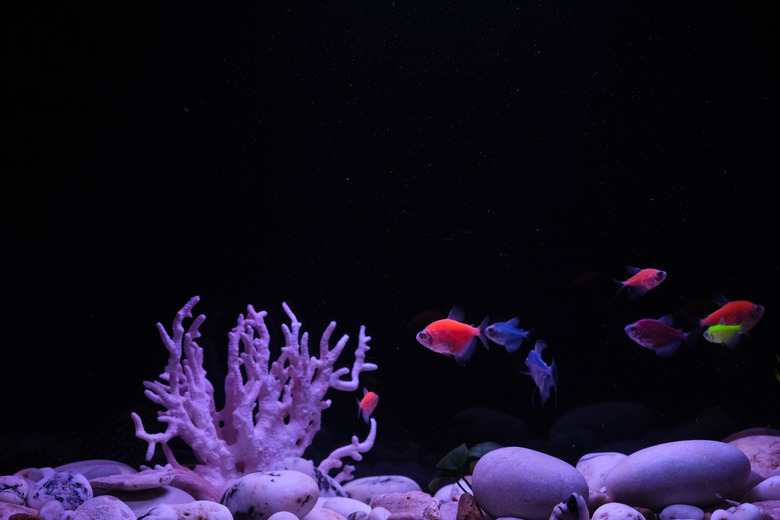Pregnant GloFish
GloFish are never actually pregnant. Like the other genetically similar fish, such as tetras and danios, they are egg layers and do not bear live offspring, so technically, GloFish can not undergo pregnancy. Females do swell when carrying eggs, creating the appearance of pregnancy. A swollen belly means a female GloFish is ready to drop eggs.
GloFish genetics
GloFish genetics
GloFish are genetically modified fish specifically engineered to glow in bright neon colors under light. Scientists started with zebra danio fish — a compatible tank mate with neon tetras — and injected a danio embryo with naturally occurring fluorescence protein genes from other marine animals, including jellyfish and sea coral. Successive offspring carried the gene, resulting in fish who were intended to be used for scientific purposes and glow in the presence of pollution.
Because GloFish were essentially created or invented, they are legally patented. In 2003, GloFish were released on the market as neon red, green, orange, and blue glowing pets. Different fluorescents colors are a result of different types of marine animal proteins. Fish species genetically engineered to glow include barbs, tetras, danios, and bettas.
Legally breeding GloFish
Legally breeding GloFish
GloFish, also called Glow Fish, are actually a brand of fish. "GloFish" is a registered trademark and is exclusively licensed by GloFish LLC. Only the GloFish company can sell this genetically modified fish. However, that doesn't mean you cannot breed them.
You simply cannot sell, barter, or give them away, and you definitely can't release GloFish into the wild because that's illegal. Concerns about GloFish becoming an invasive species and impacting existing marine life led to GloFish not being legal in the state of California.
GloFish egg laying
GloFish egg laying
GloFish follow the same breeding process as danios, their original species. Both male and female GloFish release pheromones to initiate egg production and release. Female GloFish can lay eggs every two to three days. Several hundred eggs make up a single clutch.
Females release eggs that fall to the bottom of the tank, and males swim behind fertilizing them. Like danios, GloFish spawn in groups, and eggs from one female will likely be fertilized by more than one male. Like other community fish, they should be kept in schools of six or more.
GloFish fry size
GloFish fry size
Don't be disappointed if you don't see baby GloFish or fry. Survival of fertilized eggs is unlikely because adult fish often consume them immediately. Placing marbles or rocks at the bottom of the tank can help provide some shielding or hiding places for eggs. In a day or two, eggs that fall to the bottom will hatch.
Fry will stay hidden for two or three days before venturing out to search for food. To increase the chances the fry will survive, most fish breeders have separate breeding tanks. After eggs are released and fertilized in the breeding tank, remove the adult GloFish and return them to their original habitat. Otherwise, fry might be eaten.
Color of GloFish fry
Color of GloFish fry
Offspring of GloFish will also be florescent and will glow, especially under black light. The genes for bright colors characteristic of these modified danios, tetras, barbs, and bettas are passed to subsequent generations. Most danio GloFish grow to about 2 inches long. To maintain their characteristic colors, GloFish should be kept in temperatures between 65 and 75 degrees Fahrenheit in water with a pH of 6.5 to 8.
